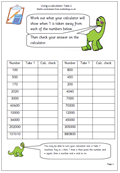 Most children have access to a calculator, and there are very good reasons why their use should be encouraged. However, there is still a great deal of opposition to them. I certainly would not advocate their use to solve simple sums which can be done mentally or on paper, but they are great for investigations and improving attitudes to maths.
Most children have access to a calculator, and there are very good reasons why their use should be encouraged. However, there is still a great deal of opposition to them. I certainly would not advocate their use to solve simple sums which can be done mentally or on paper, but they are great for investigations and improving attitudes to maths.
This first calculator page uses the calculator as a quick check for mental arithmetic. Taking one from a number might appear very easy, but with large numbers such as 20200 it requires a good knowledge of place value.
This page also introduces the idea of the calculator as a function machine, in this case a ‘take 1’ machine. With many calculators by keying in the minus sign (-) followed by 1 then the equals sign the answer -1 is shown. Ignore this, don’t clear the answer, and type in another number eg 450 and press the equals sign and the answer will come up (449). Continuing in this way saves time as it more than halves the number of entries to type in. It can, of course be applied to any subtraction which has to be done on numerous occasions.